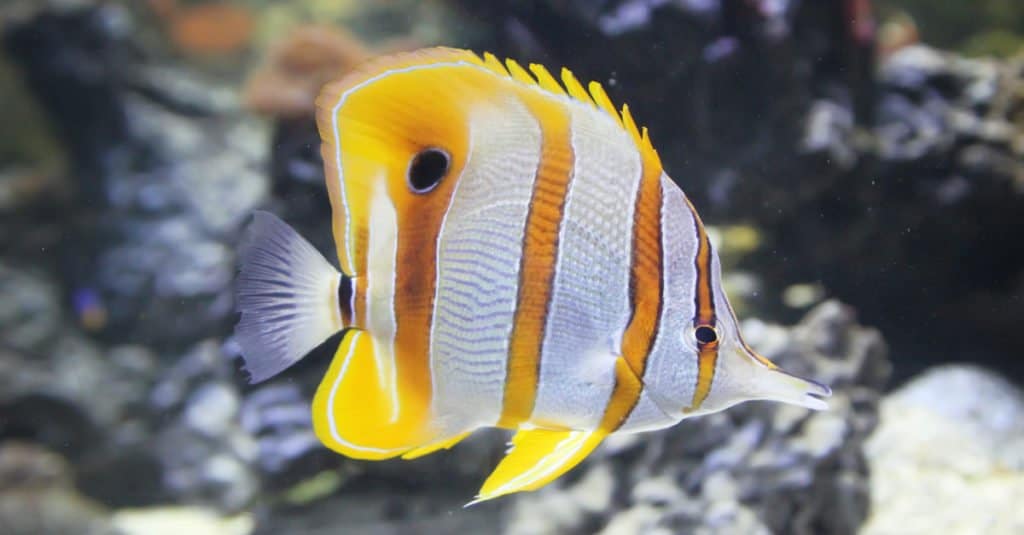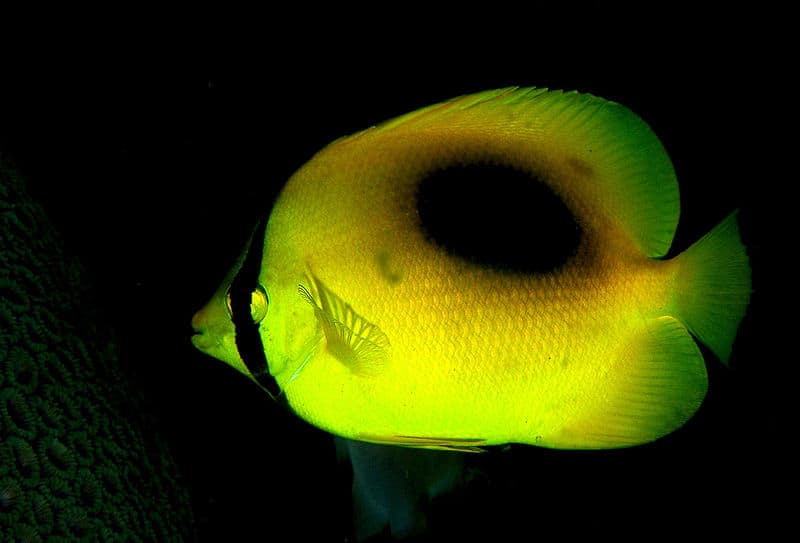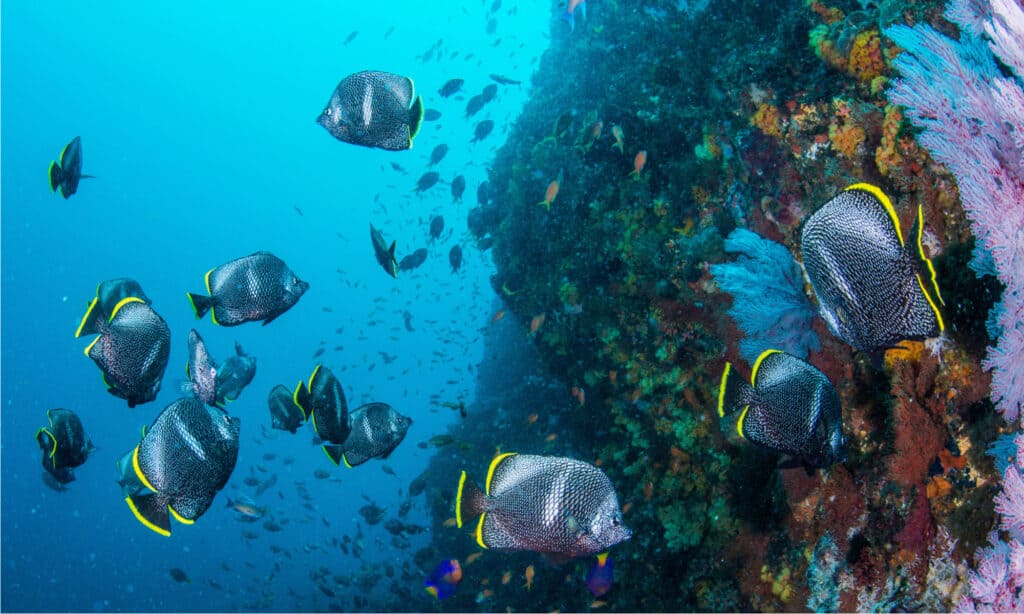Butterfly Fish
Chaetodontidae
The butterfly fish has a black spot on its back, most likely to distract predators.
Advertisement
Butterfly Fish Scientific Classification
- Kingdom
- Animalia
- Phylum
- Chordata
- Class
- Actinopterygii
- Order
- Perciformes
- Family
- Chaetodontidae
- Scientific Name
- Chaetodontidae
Read our Complete Guide to Classification of Animals.
Butterfly Fish Conservation Status
Butterfly Fish Facts
- Prey
- Small invertebrates and plant matter
- Main Prey
- Plankton, Coral, Crustaceans
- Group Behavior
- Solitary/School
- Fun Fact
- The butterfly fish has a black spot on its back, most likely to distract predators.
- Estimated Population Size
- unknown
- Biggest Threat
- Destruction of coral reefs
- Most Distinctive Feature
- Bright colors
- Distinctive Feature
- Elongated nose and bright colours
- Other Name(s)
- Butterflyfish
- Gestation Period
- 30 hours
- Optimum pH Level
- 8.1 - 8.6
- Habitat
- Coral reefs, mudflats, seagrass beds and lagoons
- Predators
- Fish, Eels, Sharks
- Diet
- Omnivore
- Favorite Food
- Plankton
- Type
- Ray-finned fish
- Common Name
- Butterfly fish
- Number Of Species
- 115
- Average Clutch Size
- 200
- Slogan
- There are more than 100 different species!
View all of the Butterfly Fish images!

The butterfly fish is a family of tropical marine animals that have adapted to life in and around coral reefs. The seemingly endless permutations of beautiful colors and patterns give each species an entirely distinctive appearance, much like the famous insect for which it’s named. In fact, their vivid appearance and rather a docile personality have made them a very popular type of aquarium fish.
4 Butterfly Fish Facts

Wrought Iron Butterflyfish (Chaetodon daedalma) in display tank Tokyo, Japan. The reason that this species of butterfly fish has its name is the metallic black color of its body.
©chonlasub woravichan/Shutterstock.com
The butterfly fish are a group of tropical marine fish of the family Chaetodontidae. The bannerfish and coralfish are also mixed into this group. There are about 129 species of butterfly tropical marine fish but many are found in the reefs of the Atlantic, Indian, and Pacific oceans.
Butterfly fish look a lot like angelfishes but they don’t have the preopercle spines that gill covers. Some members of the Henniochus look a lot like Morrish idols.
Additionally, here is a few interesting facts about the butterfly fish.
- This fish is most active during the day and sleeps at night in crevices and hiding spots.
- This fish can change its colors automatically depending on the situation. The bright colors often fade during the nighttime to blend in with the coral reefs. But the colors become even brighter when the fish feels antagonized.
- Most of these fish travel around in schools or pairs for feeding and protection, but some are highly territorial.
- The butterfly fish relies on its sight to find prey and communicate with others. If two fish become separated, then one may swim upward to alert the other of its presence.
Classification and Scientific Name

The scientific name for the butterfly fish family is Chaetodontidae.
©Vladislav Gajic/Shutterstock.com
The scientific name for the butterfly fish family is Chaetodontidae. This is a combination of two Ancient Greek words: chaite, meaning hair, and odontos, meaning tooth. This is probably a reference to the rows of brush-like teeth in the mouth. This family should not be confused with the freshwater butterflyfish (also known as the African butterflyfish).
Endemic to the West African region, the freshwater butterflyfish belongs to an entirely different order. Given their different appearance, distribution, and behavior, they are not closely related at all. The freshwater butterflyfish is more closely related to other African fish in the order of Osteoglossiformes.
Evolution and Origins

These fish are well known for their unique, flattened bodies and bright colors, which help them blend into the coral reefs they inhabit.
Butterfly fish are a group of brightly colored, tropical fish that belong to the family Chaetodontidae. These fish are well known for their unique, flattened bodies and bright colors, which help them blend into the coral reefs they inhabit. But where did these distinctive fish come from, and how did they evolve into the creatures we see today?
The origins of butterfly fish can be traced back to the Late Cretaceous period, approximately 100 million years ago. Fossil evidence shows that early butterfly fish were similar in appearance to modern-day species, with a flat, laterally compressed body and a broad, triangular snout. Over time, these fish continued to evolve, adapting to their changing environments and developing new behaviors and physical adaptations to help them survive and thrive.
One of the most notable adaptations in butterflyfish is their brightly colored bodies. This coloring serves a dual purpose, helping the fish blend in with their surroundings and providing protection from predators. Many species of butterfly fish are brightly colored on one side and have a more muted, camouflaged appearance on the other. This helps the fish blend into their surroundings when viewed from different angles, making them less visible to predators.
In addition to their coloring, butterfly fish also have specialized adaptations that allow them to feed on small invertebrates and other prey. They have a narrow, pointed snout that they use to probe crevices in the reef and extract their food. They also have small, pointed teeth that are ideal for grabbing and crushing small prey.
Species

Wrought Iron Butterflyfish prefer to live in depths of at least 33 feet, and they are found in schools with at least 10 other individual fish.
©divedog/Shutterstock.com
This fish family contains about 115 species of fish, each with a unique pattern and color. There are 12 genera in total, but the one genus of Chaetodon contains some 90 species alone.
- Foureye Butterfly Fish: Native to the Atlantic Ocean from Massachusetts to South America, this species has a very recognizable white and blue body with darker stripes emanating out from the center. The name probably derives from the very long and prominent black spot near the tail surrounded by a white ring.
- Copperband Butterfly Fish: Endemic to the Pacific and Indian Oceans, this species has alternating stripes of white and orange around the body. It also has a particularly long snout.
- Blacknosed Butterfly Fish: Also known as the barberfish, this East Pacific species (which congregates around the Galapagos Island) has a yellow body, a white face, and black markings around the upper fin and parts of the face.
Here is a full list of Butterfly Fish:
- Foureye butterflyfish
- Copperband butterflyfish
- Threadfin butterflyfish
- Banded butterflyfish
- Forceps fish
- Raccoon butterflyfish
- Vagabond butterflyfish
- Redtail butterflyfish
- Freshwater butterflyfish
- Spotfin butterflyfish
- Saddle butterflyfish
- Lined butterflyfish
- Blackback butterflyfish
- Oval butterflyfish
- Sunburst butterflyfish
- Diagonal butterflyfish
- Schooling bannerfish
- Pyramid butterflyfish
- Pearlscale butterflyfish
- Teardrop butterflyfish
- Atoll butterflyfish
- Chaetodon ulietensis
- Bluecheek butterflyfish
- Mirror butterflyfish
- Eight band butterflyfish
- Bluelashed butterflyfish
- Peppered butterflyfish
- Yellow-dotted butterflyfish
- Chevron butterflyfish
- Three-banded butterflyfish
- Ornate butterflyfish
- Blackwedged butterflyfish
- Reef butterflyfish
- Forcipiger longirostris
- Latticed butterflyfish
- Melon butterflyfish
- Pennant coralfish
- Chaetodon pelewensis
- Pebbled butterflyfish
- Philippine butterflyfish
- Fourspot butterflyfish
- Millet butterflyfish
- Speckled butterflyfish
- Scrawled butterflyfish
- Bluestripe butterflyfish
- Crown butterflyfish
- Blacktail butterflyfish
- Dotted butterflyfish
- Chaetodon auripes
- Seychelles butterflyfish
- Yellowhead butterflyfish
Appearance
The butterfly fish sometimes looks like the wings of a butterfly. It has a big, round but flat body with prominent fins around the back and pelvis. The dorsal fin on the back sometimes features sharp spines which provide a defense against potential predators. As mentioned previously, this family is named for the small rows of bristle-like teeth in the mouth. Some have long snouts and jaws (up to 25% of the body length) for grasping prey in small crevices.
The most common colors are blue, yellow, orange, and white with dark contrasting bands and large spots near the back. This spot may serve the purpose of confusing predators. The largest species of butterfly fish measures up to a foot long, but most don’t exceed more than 8 inches.

©Vladislav Gajic/Shutterstock.com
Distribution, Population, and Habitat
The butterfly fish is one of the most common types of coral reef fish in the world. It is very well adapted to life in the narrow confines of vast coral reef systems, though a few species also inhabit seagrass beds, lagoons, and mudflats. The greatest concentration of species is found in a stretch of Pacific territory between Australia and Taiwan. Only four species occur in the Eastern Pacific and 13 in the Atlantic Ocean. Their preferred habitat is the shallow warm water less than 65 feet deep near shores or estuaries, but a few species reside in deep water habitats up to 650 feet.
The IUCN Red List has classified most species as least concern. This means the butterfly fish is in excellent health and requires no specific conservation efforts to survive. However, the butterfly fish is so well adapted to its habitat that the die-off of coral reefs from climate change may threaten many species.
Predators and Prey
The butterfly fish likes to hunt and sleep in a narrow range of territory around coral heads. These also provide it with protection.
What does the butterfly fish eat?
Feeding at the bottom layer of the sea, the butterfly fish has evolved all kinds of jaw sizes and shapes to probe narrow cracks for food. Its favorite foods include small invertebrates such as sponges and worms. Some species also feed on coral polyps, algae, and plankton.
What eats the butterfly fish?
The butterfly fish is preyed up by sharks, eels, snappers, and other large fish. If danger appears, then this creature has the ability to hide in small crevices around coral reefs. Many species have also evolved spines, armor, and toxins to deal with threats.
Reproduction and Lifespan

The butterfly fish mates at a very specific time of the year. In the tropics, the spawning season usually peaks in winter or early spring.
©Lieutenant Elizabeth Crapo, NOAA Corps, Public domain, via Wikimedia Commons – License
The butterfly fish mates at a very specific time of the year. In the tropics, the spawning season usually peaks in winter or early spring. In temperate climates, the spawning season takes place in the summer. The butterfly fish forms stable monogamous pairs for at least three years and sometimes their entire lives.
When a female is ready to mate, her abdomen becomes swollen with eggs. The male will come up from behind and gently nudge her abdomen with its snout. They will release the eggs and sperm together, creating a white cloud in the water. Some enterprising males without a mate may swim in and quickly add their sperm to the cloud.
Once fertilized, the eggs hatch in a mere 28 to 30 hours later. Parents likely play almost no role in raising and caring for the young, but in order to protect itself, the butterfly fish has a unique larval stage in which it develops a plate of bony armor over the head. This plate eventually extends outward along the back to form spines. These spines are eventually absorbed into the body.
After growing to about the size of a coin, the fish will soon enter into a juvenile stage and exhibit different color patterns from its adult form. It will usually find a temporary home within small tidal pools or shallow areas before moving out to the corals. After about a year, the butterfly fish can expect to begin breeding. It has a full life expectancy of five to 10 years in the wild.
Fishing and Cooking
The butterfly fish is almost never caught for food, but it is popular in the exotic pet trade.
View all 285 animals that start with BButterfly Fish FAQs (Frequently Asked Questions)
Are Butterfly Fish herbivores, carnivores, or omnivores?
Butterfly Fish are Omnivores, meaning they eat both plants and other animals.
What Kingdom do Butterfly Fish belong to?
Butterfly Fish belong to the Kingdom Animalia.
What phylum do Butterfly Fish belong to?
Butterfly Fish belong to the phylum Chordata.
What class do Butterfly Fish belong to?
Butterfly Fish belong to the class Actinopterygii.
How do you take care of a butterfly fish?
If you plan to add a butterfly fish to your aquarium, then you should have a large tank of at least 70 gallons (and perhaps as much as 150 gallons) with plenty of reefs and other small hiding places. The temperature should be ideally set to 72 to 78 degrees Fahrenheit. The butterfly fish can be fed on a standard diet of tropical fish food and flakes with a mixture of plants and meat. Tank mates can include gobies, parrotfish, and clownfish, but some species may be more territorial than others.
What do Butterfly Fish eat?
Butterfly Fish eat plankton, coral, and crustaceans.
What are some predators of Butterfly Fish?
Predators of Butterfly Fish include fish, eels, and sharks.
What are some distinguishing features of Butterfly Fish?
Butterfly Fish have elongated noses and bright colors.
What is the average clutch size of a Butterfly Fish?
Butterfly Fish typically lay 200 eggs.
What is an interesting fact about Butterfly Fish?
There are more than 100 different species of Butterfly Fish!
What is the scientific name for the Butterfly Fish?
The scientific name for the Butterfly Fish is Chaetodontidae.
What is the lifespan of a Butterfly Fish?
Butterfly Fish can live for 5 to 10 years.
What is the biggest threat to the Butterfly Fish?
The biggest threat to the Butterfly Fish is destruction of coral reefs.
What is the optimal pH for a Butterfly Fish?
The optimal pH for a Butterfly Fish is between 8.1 and 8.6.
How many Butterfly Fish are left in the world?
The population size of the Butterfly Fish is unknown.
How to say Butterfly Fish in ...
Thank you for reading! Have some feedback for us? Contact the AZ Animals editorial team.
Sources
- Brittanica, Available here: https://www.britannica.com/animal/butterflyfish
- Animal Diversity Web, Available here: https://animaldiversity.org/accounts/Chaetodontidae/
- Fish Aroma, Available here: https://fisharoma.com/butterflyfish/

















